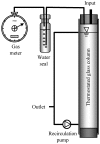Microbial Community Shifts during Biogas Production from Biowaste and/or Propionate
- PMID: 28955012
- PMCID: PMC5597126
- DOI: 10.3390/bioengineering2010035
Microbial Community Shifts during Biogas Production from Biowaste and/or Propionate
Abstract
Propionate is the most delicate intermediate during anaerobic digestion as its degradation is thermodynamically unfavorable. To determine its maximum possible degradation rates during anaerobic digestion, a reactor was fed Monday to Friday with an organic loading rate (OLR) of 12/14 kg CODbiowaste·m-3·d-1 plus propionate up to a final OLR of 18 kg COD·m-3·d-1. No feed was supplied on weekends as it was the case in full-scale. To maintain permanently high propionate oxidizing activity (POA), a basic OLR of 3 kg CODpropionate·m-3·d-1 all week + 11 kg CODbiowaste·m-3·d-1 from Monday to Friday was supplied. Finally a reactor was operated with an OLR of 12 kg CODbiowaste·m-3·d-1 from Monday to Friday and 5 kg CODpropionate·m-3·d-1 from Friday night to Monday morning to maintain a constant gas production for permanent operation of a gas engine. The propionate degradation rates (PDRs) were determined for biowaste + propionate feeding. Decreasing PDRs during starvation were analyzed. The POA was higher after propionate supply than after biowaste feeding and decreased faster during starvation of a propionate-fed rather than a biowaste-fed inoculum. Shifts of the propionate-oxidizing and methanogenic community were determined.
Keywords: anaerobic co-digestion; biowaste; community shifts; methanogenic community; propionate; propionate-oxidizing bacteria (POB).
Conflict of interest statement
The authors declare no conflict of interest.
Figures






Similar articles
-
Scale-up of anaerobic digestion of the biowaste fraction from domestic wastes.Water Res. 2003 Mar;37(6):1433-41. doi: 10.1016/S0043-1354(02)00537-7. Water Res. 2003. PMID: 12598207
-
Propionic acid accumulation and degradation during restart of a full-scale anaerobic biowaste digester.Bioresour Technol. 2008 Jan;99(1):170-8. doi: 10.1016/j.biortech.2006.11.014. Epub 2007 Jan 2. Bioresour Technol. 2008. PMID: 17197176
-
Wet biowaste digestion: ADM1 model improvement by implementation of known genera and activity of propionate oxidizing bacteria.Water Res. 2018 Feb 1;129:384-393. doi: 10.1016/j.watres.2017.11.012. Epub 2017 Nov 7. Water Res. 2018. PMID: 29174828
-
Upflow anaerobic sludge blanket reactor--a review.Indian J Environ Health. 2001 Apr;43(2):1-82. Indian J Environ Health. 2001. PMID: 12397675 Review.
-
Overview of anaerobic treatment: thermophilic and propionate implications.Water Environ Res. 2006 May;78(5):460-73. Water Environ Res. 2006. PMID: 16752608 Review.
Cited by
-
Response of Microbial Community to Induced Failure of Anaerobic Digesters Through Overloading With Propionic Acid Followed by Process Recovery.Front Bioeng Biotechnol. 2020 Dec 11;8:604838. doi: 10.3389/fbioe.2020.604838. eCollection 2020. Front Bioeng Biotechnol. 2020. PMID: 33363133 Free PMC article.
References
-
- Gallert C., Winter J. Bacterial metabolism in wastewater treatment systems. In: Jördening H.J., Winter J., editors. Environmental Biotechnology—Concepts and Applications. Wiley-VCH; Weinheim, Germany: 2005. pp. 1–48.
-
- Li J., Ban Q., Zhang L., Jha A.K. Syntrophic propionate degradation in anaerobic digestion: A review. Int. J. Agric. Biol. 2012;14:843–850.
LinkOut - more resources
Full Text Sources
Other Literature Sources

